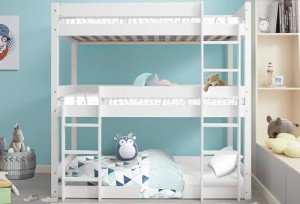Ten Bunk Beds Sale Myths You Shouldn't Share On Twitter
Bunk Beds Sale: A Comprehensive Guide to Choosing the Right Bunk Bed for Your Home
Bunk beds have actually long been a staple in children's bed rooms, using a mix of space-saving efficiency and fun. Whether accommodating siblings, pals on slumber parties, or simply making the most of a playroom, bunk beds have actually become a necessary element in modern-day family homes. As sales on bunk beds rise, it becomes significantly vital for consumers to make informed choices when buying one. This post will cover the fundamentals of buying a bunk bed, from types to security functions, in addition to ideas for keeping the integrity of your financial investment.
Kinds Of Bunk Beds
When considering a bunk bed sale, it's important to understand the various designs offered on the marketplace. Below are the most common types:
Traditional Bunk Beds: These consist of 2 beds stacked one above the other, sharing a single frame. They are often the most economical choice.
L-Shaped Bunk Beds: This design includes one bed positioned vertically and another horizontally. This arrangement develops additional space below the upper bed, which can be used for storage or a play location.
Lofted Beds: Similar to standard bunk beds however with no lower bed. Rather, the space underneath can be made use of for a desk, play location, or extra storage.
Triple Bunk Beds: For households with a larger variety of kids or frequent slumber parties, triple bunk beds provide three sleeping locations in a space-efficient style.
Futon Bunk Beds: These styles combine bunk beds and futon couches. The bottom area converts into a different seating location, improving functionality.
Convertible Bunk Beds: These beds can be separated into two individual beds, making them flexible as children's needs change gradually.
Table 1: Comparison of Bunk Bed Types
Type
Description
Space Efficiency
Additional Features
Traditional Bunk Bed
2 beds stacked vertically
High
Easiest design
L-Shaped Bunk Bed
One vertical and one horizontal bed
Moderate
Play or storage space
Lofted Bed
Elevated bed with open space listed below
High
Work/play location
Triple Bunk Bed
3 stacked beds
Very High
Accommodates more users
Futon Bunk Bed
Bunk bed with a convertible futon
High
Multi-functional
Convertible Bunk Bed
Can be divided into 2 different beds
Moderate
Versatility & & longevity
Security Features to Consider
Safety is paramount when investing in a bunk bed. Below are essential security features to look for:
Guardrails: Adequate guardrails must exist on both sides of the upper bunk to avoid falls. maxbogus.top should be at least 5 inches higher than the mattress.
Ladder Design: Look for tough, large ladders with slip-resistant rungs. Ensure that the angle is not too steep for simple gain access to.
Stability: Ensure the bed is constructed with strong materials, such as strong wood or sturdy metal. The bed should not wobble when in usage.
Weight Limit: Check the weight capability of the bunk bed to guarantee it can accommodate the desired users securely.
Product Safety: If possible, select beds made from non-toxic products or those meeting security standards for children's furnishings.
Table 2: Essential Safety Features
Function
Description
Value
Guardrails
Sides of upper bed to avoid falls
Necessary for kid security
Ladder Design
Solid, slip-resistant rungs
Aids safe and simple access
Stability
Develop quality to prevent wobbling
Guarantees safety and durability
Weight Limit
Maximum weight capability
Avoids accidents
Material Safety
Non-toxic, safe materials
Safeguards children's health
Upkeep Tips for Bunk Beds
To extend the life of your bunk bed and guarantee ongoing safety, consider the following upkeep pointers:
Regular Inspections: Periodically examine the structure for loose screws, bolts, or any indications of wear. Tighten up fasteners as required.
Tidy Periodically: Dust and clean the surfaces frequently. Usage suitable cleaners that won't damage the surface.
Inspect Weight Limits: Be conscious of weight limits, especially with older children or adults who may wish to utilize the upper bunk.
Avoid Climbing on Guardrails: Educate children not to use guardrails for climbing up or playing to reduce the risk of accidents.
Often Asked Questions (FAQs)
Q1: What is the age limitation for kids to safely utilize bunk beds?A: While it varies by the manufacturer, lots of advise that kids under 6 need to not sleep in the upper bunk due to safety concerns.
Q2: How can moms and dads prevent hazardous climbing?A: Setting clear guidelines about bunk bed usage and supervising kids can help. Furthermore, using a bed tent can prevent climbing up while creating an enjoyable sleep environment.
Q3: What should I consider when embellishing a space with bunk beds?A: Ensure there is enough space around the bunk bed for safe movement, and utilize the decoration to create personalized areas for each child.
Q4: Is a lofted bed suitable for older kids?A: Yes, lofted beds can be ideal for older kids as long as they fulfill safety requirements and the child is accountable enough to use them safely.
Bunk beds serve a functional function while including an element of enjoyable to a child's bed room. As sales of bunk beds continue to rise, mindful factor to consider of types, safety functions, and upkeep practices is essential for parents and caretakers. By understanding these crucial aspects, families can find the best bunk bed for their home, ensuring both practicality and security for many years to come. Whether it's for brother or sisters sharing a space or producing a comfortable slumber party space, a well-chosen bunk bed can offer happiness and functionality, making it a worthwhile investment.
